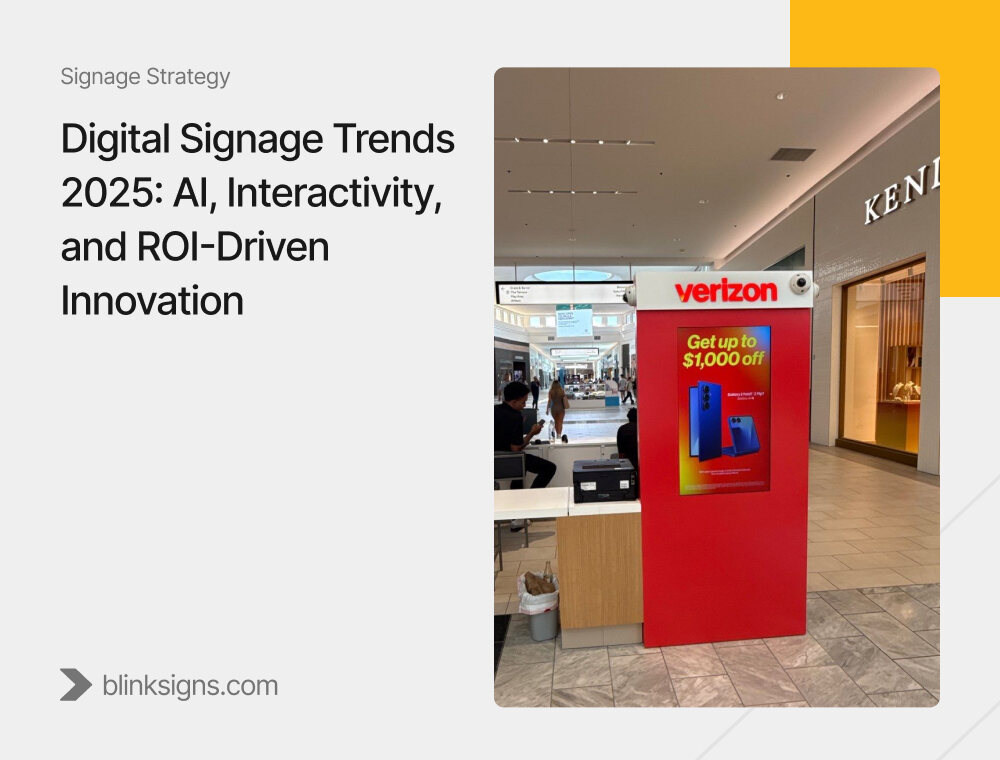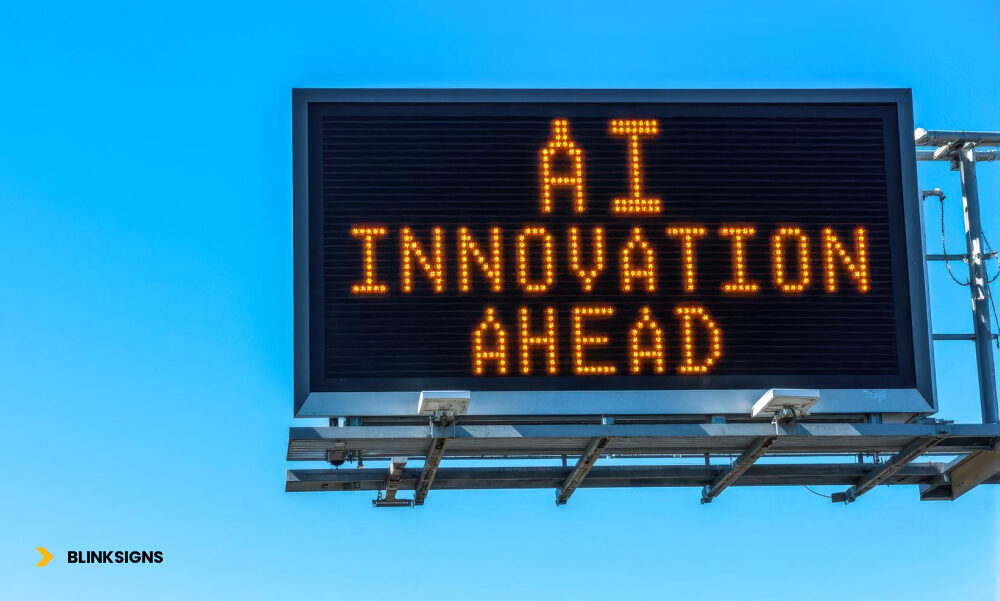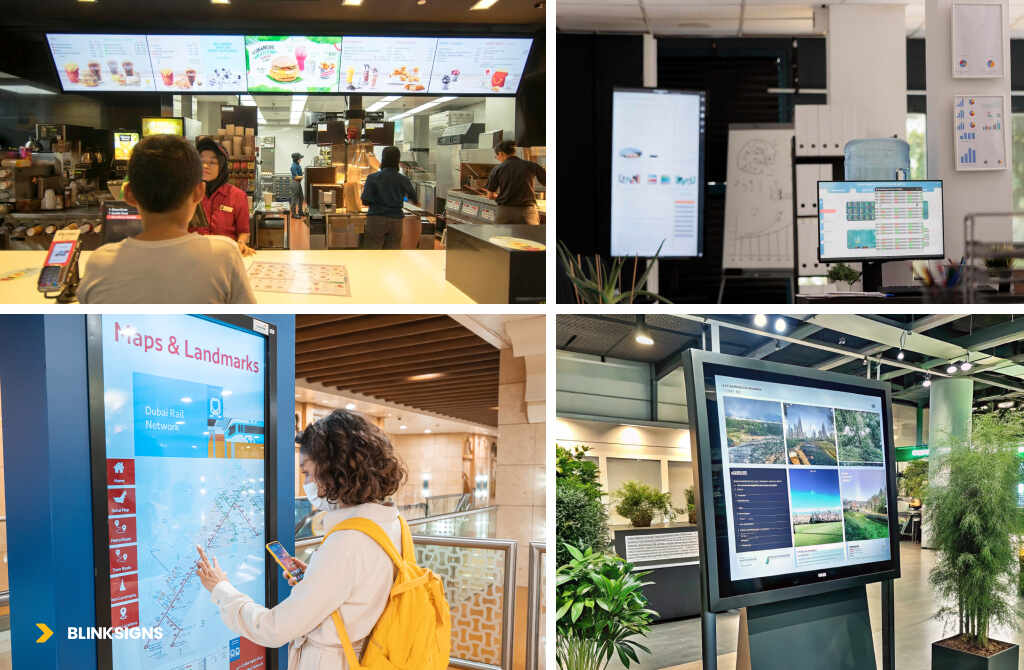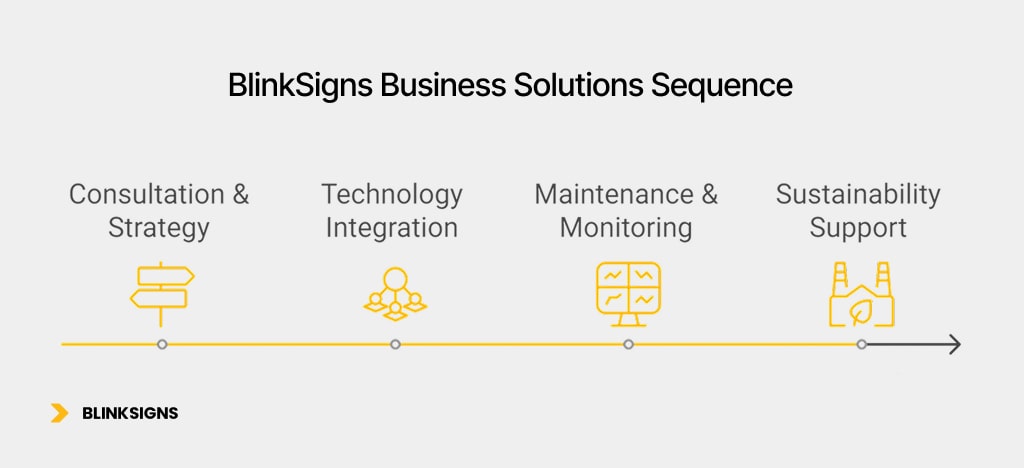
Digital Signage Trends: AI, Interactivity, and ROI-Driven Innovation
Why 2025 Is the Breakout Year for Digital Signage
Walk through a busy retail store, airport terminal, or corporate lobby in 2025, and you’ll notice something different: signs are no longer static billboards. They’ve become intelligent, interactive, and ROI-driven business tools. From AI-powered displays that adjust content in real time to immersive digital experiences that invite customer participation, digital signage is evolving at a pace businesses can’t afford to ignore.
At BlinkSigns, signage is more than a communication tool—it’s a strategic investment in brand visibility, customer engagement, and operational efficiency. 2025 marks a turning point where innovation, sustainability, and measurable outcomes converge to redefine how businesses connect with their audiences.
Why Digital Signage Is Evolving Faster in 2025

Why Digital Signage Is Evolving Faster in 2025
The global signage market is being reshaped by artificial intelligence, interactivity, and ROI measurement. Businesses are no longer satisfied with “eyeballs” alone—they demand trackable impact, energy-efficient solutions, and signage that adapts as quickly as consumer behavior.
- AI and machine learning enable more innovative content scheduling and predictive maintenance.
- Interactive technologies like gesture, touch, and voice recognition deepen customer engagement.
- ROI-driven analytics prove signage value in complex numbers: increased sales, foot traffic, and retention.
For businesses, 2025 is the year signage stops being an overhead expense and starts being a measurable growth driver.
What’s driving the growth of digital signage in 2025?
- More innovative technology (AI & automation)
- Personalized, interactive customer experiences
- Sustainability and energy efficiency
- Stronger ROI measurement tools
Artificial Intelligence at the Core of Smart Signage

Artificial Intelligence at the Core of Smart Signage
Artificial intelligence is no longer a buzzword in signage, it’s the backbone of the industry’s evolution. From predictive analytics to generative content, AI empowers businesses to deliver sharper, more relevant messages at the right time and place.
AI-Powered Content Personalization
Digital signs now adapt dynamically to external data: weather, time of day, foot traffic, or shopper demographics. A quick-service restaurant can highlight warm drinks on a cold morning, while a retail store can push discounts when traffic is high.
Predictive Maintenance & Cost Control
AI algorithms monitor real-time LED brightness, module performance, and energy use. Instead of waiting for outages, businesses get alerts before failures occur—minimizing downtime and costly emergency repairs.
Programmatic DOOH (Digital Out-of-Home)
Powered by AI, programmatic ad placement allows businesses to buy signage space like they purchase digital ads—targeted, real-time, and measurable. This shift brings digital signage into the same performance-driven category as online advertising.
How is AI changing digital signage?
- Enables real-time content personalization
- Predicts and prevents hardware failures
- Optimizes ad spend with programmatic buying
- Reduces energy waste with intelligent calibration
Interactivity & Immersive Experiences: Beyond Static Displays

Interactivity & Immersive Experiences
One of the biggest trends in 2025 is the rise of interactive signage—signs that don’t just display content but invite customers to engage with it.
Touch & Gesture Recognition
Retailers use gesture-controlled screens to let customers browse catalogs without touching surfaces, while museums deploy touch-enabled kiosks for educational experiences.
Voice-Activated Signage
Hospitality and healthcare environments are adopting voice commands for wayfinding, accessibility, and multilingual support—enhancing inclusivity and convenience.
AR & VR Integration
Augmented and virtual reality expand signage into immersive brand experiences. Imagine scanning a QR code at a hotel digital display and previewing your suite in 3D before check-in.
Customer Engagement Impact
Studies show interactive displays increase dwell time by up to 40% compared to static signage. More time before your message means stronger recall, higher conversions, and measurable ROI.
Is interactive signage worth the investment?
- Boosts engagement and dwell time
- Provides memorable brand experiences
- Supports accessibility and personalization
- Converts passive viewers into active participants
ROI-Driven Strategies: Proving the Value of Digital Signage
For years, businesses questioned whether digital signage was worth the investment. In 2025, that debate is over. With advanced analytics and measurable KPIs, signage now sits alongside digital ads, social campaigns, and e-commerce as a trackable ROI channel.
Key ROI Metrics Businesses Monitor
- Foot Traffic Lift: Measuring how signage increases walk-ins using AI-powered sensors.
- Conversion Rates: Tracking sales uplift when promotions run on digital screens.
- Engagement Time: Calculating dwell time for interactive displays.
- Operational Efficiency: Reducing staff costs with automated menus, wayfinding, and announcements.
Real-World Cost Savings
- LED-based signage reduces energy costs by up to 80% compared to legacy neon or fluorescent systems.
- Predictive maintenance prevents expensive emergency service calls, cutting lifecycle costs by 30–40%.
- Content automation eliminates repetitive design expenses.
How can businesses measure ROI from digital signage?
- Track sales and conversions tied to promotions.
- Monitor dwell time and engagement metrics.
- Compare energy savings vs. traditional signs.
- Use AI-driven analytics for real-time reporting.
Industry-Specific Use Cases for Digital Signage in 2025

Industry-Specific Use Cases for Digital Signage in 2025
Every industry adopts digital signage differently—but all share the same need for visibility, engagement, and compliance.
Retail & QSR (Quick Service Restaurants)
- Dynamic menu boards update pricing instantly.
- AI analyzes demand trends to push profitable items.
- Interactive kiosks reduce checkout lines and increase upsell opportunities.
Healthcare & Hospitals
- Wayfinding kiosks with voice + touch navigation improve patient experience.
- Emergency alert systems integrated with signage ensure compliance.
- Multilingual digital displays support accessibility and inclusivity.
Hospitality & Travel
- Hotels use digital signage for personalized welcomes and local recommendations.
- Airports rely on real-time display updates for flight schedules, reducing stress and delays.
- Resorts deploy AR-enhanced signage for immersive guest experiences.
Corporate & Education
- Internal communications via digital boards replace bulletin boards.
- Universities use interactive wayfinding + event displays to guide students.
- AI-driven dashboards display KPIs, performance data, and compliance updates.
Which industries benefit most from digital signage in 2025?
- Retail, hospitality, healthcare, travel, corporate offices, and education
- Any sector needing real-time communication and engagement
Sustainability & Green Signage Initiatives
Sustainability is no longer a side consideration—it’s a business mandate. In 2025, signage is at the forefront of green innovation.
Eco-Friendly Materials & Manufacturing
- Weather-resistant, recyclable sign faces.
- Sustainable paints, coatings, and eco-material housings.
Energy-Efficient Operations
- LED retrofits cut consumption by 60–80%
- Innovative dimming systems adjust brightness based on ambient light.
- Solar-powered signage options for off-grid and remote applications.
Corporate ESG Goals
Businesses align signage strategies with Environmental, Social, and Governance (ESG) commitments. Proving sustainability in signage is not just good PR—it directly impacts investor confidence and compliance.
Future Innovations: Where Digital Signage Is Heading
The future of signage goes beyond display screens—it’s about innovative environments.
- IoT-Enabled Networks: Signs communicating with HVAC, lighting, and security systems.
- 5G-Powered Real-Time Updates: Faster, more responsive signage with cloud control.
- AI-Generated Content: Automated copywriting and design tailored to audience insights.
- Immersive 3D Holographic Displays: Transforming lobbies, retail fronts, and entertainment venues into futuristic brand canvases.
- Integration with Wearables & Mobile Devices: Personalized experiences triggered by customer proximity.
How BlinkSigns Helps Businesses Lead in 2025-26

BlinkSigns Business Solutions Sequence
At BlinkSigns, we don’t just install digital signage—we design future-ready communication ecosystems that combine aesthetics, compliance, and ROI.
Our Approach
- Consultation & Strategy: Aligning signage with business objectives.
- Technology Integration: From AI dashboards to IoT connectivity.
- Maintenance & Monitoring: Preventive schedules that protect investments.
- Sustainability Support: Helping businesses adopt greener solutions.
Whether you’re a retail chain, healthcare provider, or corporate brand, BlinkSigns ensures your signage is built not just for visibility—but for performance, compliance, and measurable impact.
FAQs: Digital Signage in 2025
Q1: Is digital signage still expensive compared to traditional signs?
Not when measured over its lifecycle. Energy savings, reduced maintenance, and increased sales typically deliver 40–60% cost savings over 5 years.
Q2: Can small businesses benefit from digital signage?
Yes. Cloud-based platforms and affordable LED solutions make digital signage scalable for single-location businesses.
Q3: What’s the most significant risk with digital signage?
The risk isn’t the technology—it’s neglecting maintenance and updates. Without a structured program, even advanced signage loses its ROI.
Q4: How do businesses ensure compliance?
Work with experienced providers like BlinkSigns who understand ADA, municipal codes, and industry regulations. Compliance is integrated into every stage of our signage process.
2025 Is the Year of ROI-Driven Signage
Digital signage trend has shifted from static communication to a dynamic strategy. In 2025, the winners will be businesses that:
- Harness AI-driven personalization
- Invest in interactive customer engagement.
- Align with sustainable practices.
- Prove ROI through analytics.
At BlinkSigns, we help businesses make that shift—transforming signage from a cost center into a growth engine.